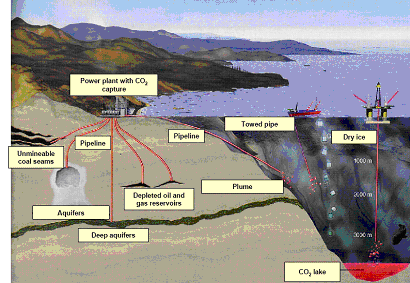
Power plant CO2 capture technologies are based upon three general concepts: post-combustion capture, pre-combustion capture, and oxyfuel combustion. Post-combustion refers to capturing CO2 from a flue gas after a fuel has been combusted in air. Pre-combustion refers to a process where a hydrocarbon fuel is gasified and water-gas shifted to form a mixture of hydrogen and CO2 and the CO2 is captured from the synthesis gas before it is combusted. Oxyfuel combustion is an approach where a hydrocarbon fuel is combusted in a mixture of oxygen and carbon dioxide, rather than air, to produce an exhaust mixture of CO2 and water vapor.
Although post-combustion capture can appear to be conceptually the simplest method of CO2 removal, the associated chemical absorption process is both expensive and energy intensive. As an alternative to post-combustion scrubbing, the combustion process can be accomplished with oxygen rather than air. With air nitrogen eliminated, a CO2-water vapor rich flue gas is generated. After partial removal of the water vapor, a portion of the flue gas is recirculated back to the boiler to control the combustion temperature and the balance of the CO2 is processed for pipeline transport. This oxygen-fired combustion process eliminates the need for the CO2 removal/separation process and, despite the expense and power consumption of air separation, reduces the cost of CO2 capture. Furthermore, oxyfuel combustion is a low-risk, high-efficiency technology. Adapting oxyfuel combustion to retrofit applications is especially important since coal firing is currently the dominant means of power generation (40 percent worldwide, 51 percent U.S.).
Oxyfuel Process
In an oxyfuel boiler the combustion air is separated into O2 and N2 and the boiler uses the O2, mixed with recycled flue gas, to combust the coal. The products of combustion are thus only CO2, water vapor, and some small impurities. The water vapor is easily condensed, yielding a nearly-pure CO2 stream ready for sequestration. The CO2 effluent is compressed at high pressure (greater than 2000 psia) and is piped from the plant to be sequestered in geologic formations (depleted oil and gas reservoirs, unmineable coal seams, saline formations, and shale formations).

Sequestration Options
(Ref.: US National Energy Technology Laboratory)
The coal is combusted in the furnace or radiant section of the boiler where the oxidizer consists of a mixture of O2 and recycled flue gas, which contains primarily CO2 gas. The furnace is specially adapted to oxyfuel by optimizing the designs of burners, ports, internal radiant surfaces, tube materials, and water/steam circuitry. Air is separated into O2 and N2 using techniques such as cryogenic air separation or the more efficient membrane-based techniques. Recycling of the flue gas (55 – 70% of the total flue gas flow) is utilized to control flame temperature in the furnace to maintain acceptable waterwall temperatures and reduce fuel NOx release. NOx formation is minimized by advanced NOx control technologies such as combustion staging and low-NOx burners.
Oxyfuel-firing of a steam boiler is a low-risk, high-efficiency technique for CO2 capture in a power plant. The steam boiler type can either be pulverized coal (PC) or circulating fluidized bed (CFB) depending on which is more suitable to the type of fuel being combusted. Oxyfuel-firing can be readily adapted to a new power plant or to retrofit applications.
In a retrofit application it is important to minimize the power plant derating and CO2 removal penalty resulting from the oxyfuel power plant conversion. In a greenfield application it is important to minimize the overall plant heat rate and CO2 removal penalty of the oxyfuel power plant. By optimizing the power plant cycle, the reduction in cycle efficiency and net power due to CO2 removal can be limited to approximately 7-10 percentage points and 10-12 percent, respectively.
The efficiency and cost-effectiveness of carbon sequestration of greenfield oxyfuel boilers can rival competing gasification plants by specifically tailoring boiler design by appropriate surface location, combustion system design, material selection, furnace layout, and water/steam circuitry. Boiler size can be substantially reduced due to higher radiative properties of O2-combustion versus air-combustion. Furthermore, a wider range of fuels can be burned due to the high oxygen content of the combustion gas and potential for high coal preheat.
Economics
The levelized cost of electricity (COE) is made up of contributions from the capital cost, operating and maintenance costs, consumables, and fuel costs. The levelized COE was calculated to be 5.0 ¢/kWh for the air-fired reference plant and 6.6 ¢/kWh for the oxyfuel plant. The CO2 mitigation cost (MC) of the oxyfuel plant was calculated at 20 $/tonne (18 $/ton).
A comparison of the COE and MC of the oxyfuel plant versus other competing CO2 removal technologies is presented below. The increase in the cost of electricity of oxyfuel is approximately 30% greater than an air-fired plant with no CO2 capture.

Conclusion
The oxyfuel power plant completely removes all CO2 generated in the combustion process and generates zero ambient air pollutants. It avoids costly CO2 separation processes, which are limited by equilibrium to only 90% CO2 removal efficiency. Of the CO2 sequestration-ready technologies, the oxyfuel requires the least modification of existing proven designs, and requires no special chemicals for CO2 separation. Furthermore, the cost-effectiveness of the oxyfuel cycle will benefit from several currently promising advanced O2 separation techniques such as membrane separation.